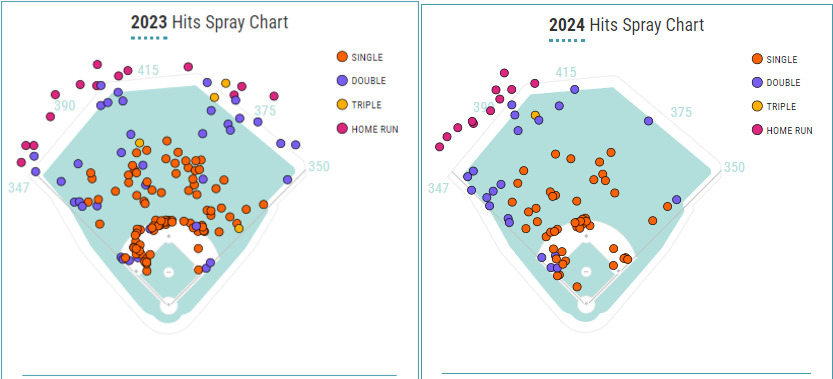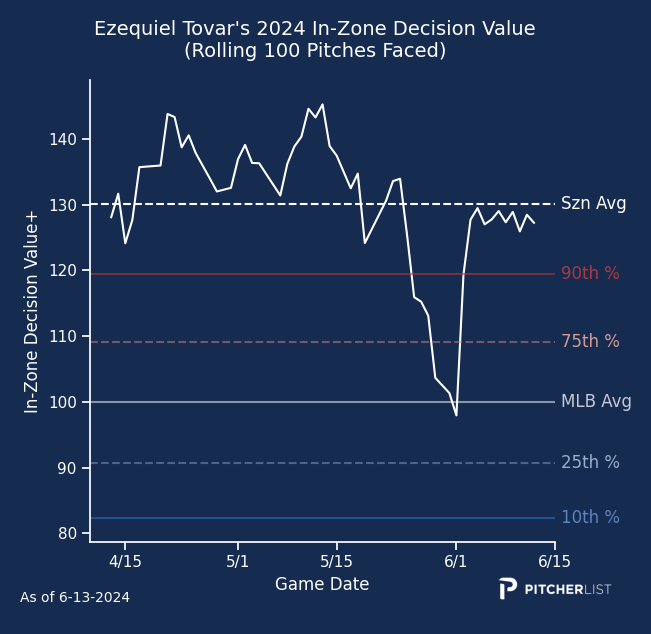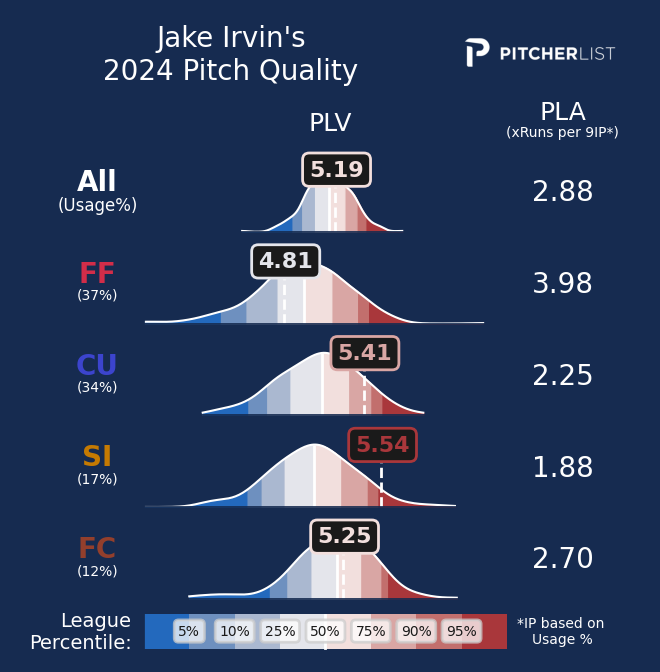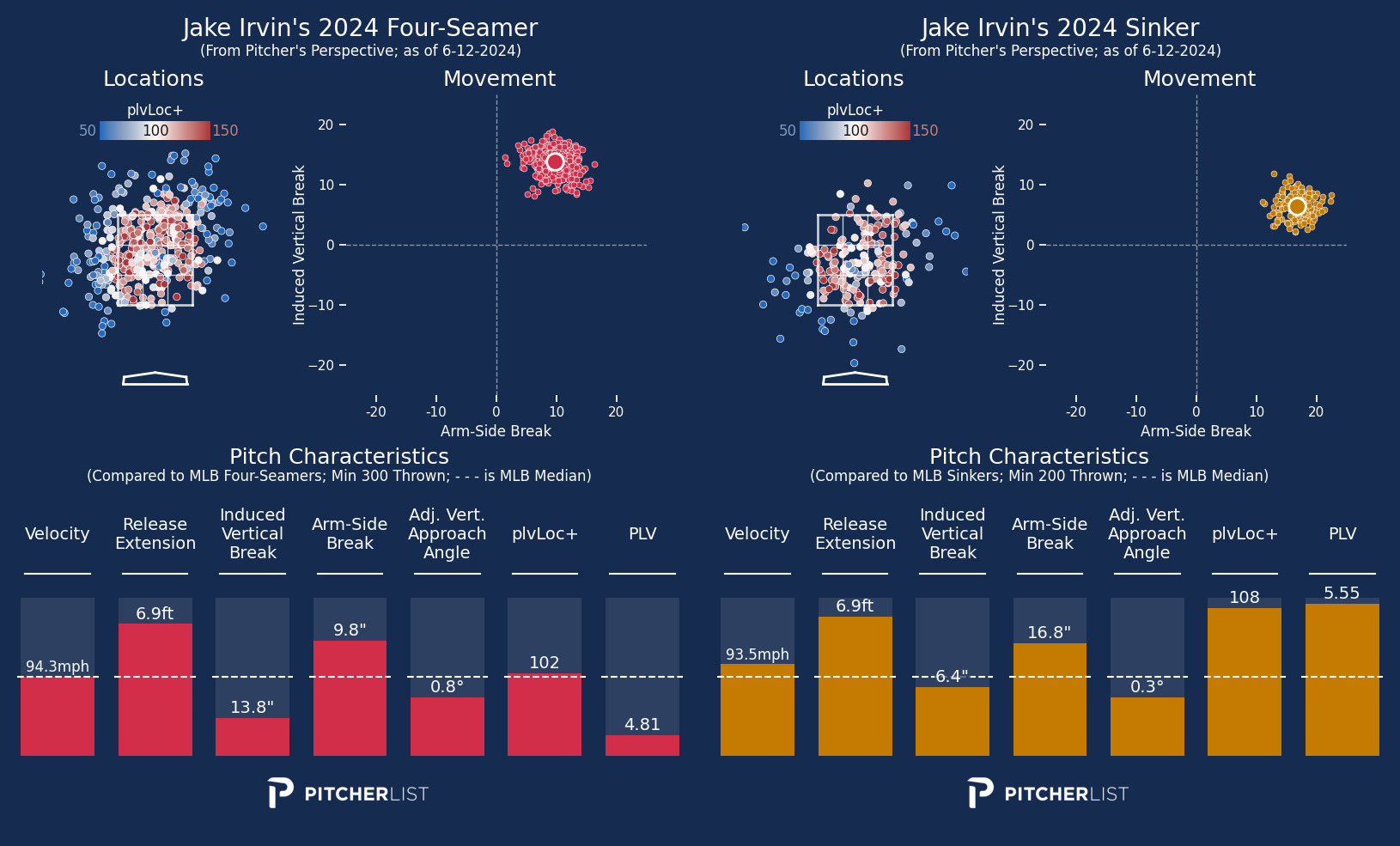Mid-season fantasy baseball moves are some of the most important you’ll make all year long. Early season excitement has faded but we’re still a couple of months away from the playoffs, so some managers in your league may be asleep at the wheel. While they miss out on making moves, you can capitalize by finding those breakout waiver wire players and making smart trade decisions that they may have missed. Today we’re diving into three players who have been making headlines with their recent play to see if they’re worth adding to your fantasy squads, or if what we’re seeing is simply a hot streak doomed to come to an end.
Ezequiel Tovar, SS, Colorado Rockies
The Rockies inked Tovar to a seven-year, $63.5 million contract extension just before Opening Day and that move looks like it’ll pay dividends. Tovar’s coming off a forgettable rookie year. He hit .253 with 15 homers, 79 runs, 73 RBI, and 11 stolen bases, numbers that made him worth a roster spot in deeper fantasy formats, but that didn’t look particularly impressive in terms of real-life run production. His 70 wRC+ in 2023 was the fourth-lowest of any qualified hitter, besting only Tim Anderson, Javier Báez, and Myles Straw — not exactly the company you want your rookie shortstop to be keeping.
One year later, Tovar’s looked much better. He’s slashing .293/.322/.493 and already has 11 home runs. His wRC+ has jumped considerably to 112, making him valuable not just in the field, but also at the plate. He’s looked more and more comfortable at the dish as the season’s progressed which perhaps shouldn’t be surprising for a player just 22 years old.
The biggest difference in Tovar’s profile is his power numbers. He posted 15 home runs and 37 doubles in 615 plate appearances last season, and through just 311 trips to the plate in 2024 he’s sitting at 11 big flies and 22 doubles, well on his way to blow past last year’s numbers. He’s found that power stroke in the most sustainable way you can: by pulling more balls in the air harder. His barrel rate has increased modestly from 8.1% to 8.9%, but his flyball and pull rates have jumped dramatically: 33.8% to 46.7% and 33.6% to 41.6%, respectively.
You can see his approach change incredibly well in his spray chart.

The big downside to this approach change is that it typically leads to more easy flyball outs, decreasing a hitter’s batting average. Tovar’s been able to avoid that fate so far, but I have to wonder how he’ll fare when his league-leading .370 BABIP inevitably comes back down. Good speed and Coors Field will help keep his BABIP higher than most batters, but .370 certainly won’t stick.
Although Tovar’s hitting the ball better this year, his expected statistics still aren’t anything to write home about. Baseball Savant’s X-stats paint a more negative picture than our X-stats here at Pitcher List do, but no matter where you look his numbers are league-average at best. Savant gives him a .239 xBA and .292 xwOBA while we give him a .254 xAVG and .319 xwOBA.
One of Tovar’s most glaring holes is his dismal plate discipline, and unlike most of his profile, it hasn’t gotten better in his sophomore campaign. Both his strikeout (27%) and walk (3.5%) rates have worsened slightly this year, but his swinging-strike rate has jumped from 17.1% to 19.8%. His 34% whiff rate is just 4th percentile among hitters while his 44.6% chase rate is 1st percentile. There is one very weird thing about Tovar’s swing profile. Although he chases everything, PLV actually grades him well above average at making swing decisions at pitches located in the strike zone. His 130 zDV is the 13th-best in baseball.

Verdict: Legit with flaws. Tovar’s batted-ball improvements are good to see. He’s gaining more power with a new approach that he can reasonably sustain. His newfound gains don’t make him a fantasy superstar, but they do increase his fantasy value from usable only in deep formats to being rosterable in 12-teamers as well. There may be another level in Tovar if he can ever cut back on his abysmal chase rates, but that’s a risky bet to make. It’s one that may be worth taking a shot on if you’re in rebuilding mode in a dynasty league, but there’s also a chance that he’s just a big swing-and-miss bat, a la Javier Báez with less power upside.
Heliot Ramos, OF, San Francisco Giants
Ramos is a former top prospect who’s fallen from grace. He was a first-round draft pick in 2017 and cracked top 100 lists for a couple of years, but recently has looked much more like a quad-A player than an impact big-league bat. That’s changed in his third run with the Giants. In 145 plate appearances this year, Ramos is slashing .325/.407/.571 with eight home runs and a stolen base. Since being called up on May 8th, both of Ramos’ 1.8 fWAR and 167 wRC+ are top-10 in baseball.
Writers love describing short MLB stints for young players as cups of coffee, and to make that analogy with Ramos’, his cup would be those little tiny espresso mugs. He hasn’t been given much of a chance yet. He posted just 22 plate appearances in 2022 and 60 plate appearances in 2023. That makes comparing his current MLB stats to previous years a fool’s errand. What we can tell from glancing at his profile is that he makes serious amounts of loud contact. Ramos’ 17.3% barrel rate is the 11th-highest since he debuted this year, and that’s just the tip of the iceberg. His 33.3% hard contact rate is 39th best. His 92.7 mph FB EV is 96th percentile. Put it all together and you get expected statistics among the best in baseball. He doesn’t have enough plate appearances to qualify, but if he did, his Statscast xSLG and xwOBA would be 90th+ percentile.

On the back of that strong hard-hit profile, Ramos is running a sky-high BABIP of .429. You expect a good BABIP with the quality of contact he’s making, but a number that high is clearly unsustainable. The qualified league leader right now is the player just above him in this article, Ezequiel Tovar, and his BABIP is .370. Ramos’ will go down quite a bit, and it scares me to think about the damage it’ll do to his overall slash line.
One change we can clearly see in Ramos’ small-sample profile is that he’s curbed his swing rate this year. His swing rate was above league average during his first two tiny espresso cups of coffee, and this time he’s lowered it to slightly below average. That’s worked out quite well for Ramos as pitchers have largely been pitching him outside of the strike zone. His 44.6% zone rate is 26th percentile among hitters and his 60.9% strike rate is just 11th percentile. Seeing so many pitches outside the strike zone while swinging less overall has led to Ramos posting an 11.7% walk rate.
On the other side of the plate discipline discussion, Ramos swings and misses a lot. Even though he swings at pitches outside of the zone at a rate four points better than average, he still whiffs all too often. His 32.1% whiff rate is 13th percentile. That’s led him to punch out 29% of the time this year.
It’s a weird swing profile overall. Ramos walks at a good rate, sees a disproportionately low number of strikes, doesn’t swing too often at pitches outside of the zone, yet still strikes out more than most hitters. Statcast’s new bat tracking metrics show that Ramos’ average swing speed is 75.8 mph and his fast swing rate is 65.3%. Both of those are top-10 marks among hitters with at least 200 swings this year. It seems that Ramos’s swing stats point to an all-or-nothing approach, making him a hitter who doesn’t necessarily have a slower, more contact-oriented swing that he can pivot to late in counts or situations where contact matters much more than driving the baseball.
Verdict: Not Legit. With such strong batted ball numbers, I wanted to love what Ramos is doing but I just can’t fully buy into it. This feels like a really long hot streak backed by a ridiculously high BABIP. That said, I’ve added Ramos in a couple of leagues and see no issue doing so if he’s on your waiver wire. Riding out hot streaks is a great way to find production, but it can be hard to figure out when that hot streak has officially ended so you’re not left holding a player who’s now hurting your team. If you’ve been rostering Ramos for a while and can move him for a player that’ll help address your team’s other needs, I’d make the move.
Jake Irvin, SP, Washington Nationals
Irvin’s been one of the biggest surprises of the 2024 season so far. Through 14 starts, he owns a 5-5 record with a 3.00 ERA, 1.04 WHP, 21.3% strikeout rate, and 4.6% walk rate, plus, he’s only looked better as the year’s gone on. Irvin’s currently riding a five-game Quality Start streak and has only given up more than three earned runs three times, and those starts came against the elite Phillies’ and Dodgers’ lineups.
I feel confident saying that pretty much no one saw this coming from Irvin entering the season. He posted a 4.61 ERA and 1.42 WHIP over 121 innings in his rookie campaign in 2023, and the best pre-season projection I can find for him was ATC giving him a 4.85 ERA and 1.38 WHIP. So what is he doing right that’s led to his newfound success? Let’s dive in.
Irving doesn’t blow away hitters with elite velocity or even superb stuff. He throws three fastballs and all of them rate between the 58th and 67th percentile in terms of velocity. Stuff-wise, the story is pretty much the same. Irvin rates as slightly above average overall with a 5.19 PLV and a 57 overall (on the 20-80 scale) from Pitching Bot. Stuff+ actually sees his arsenal as mediocre, grading it at a 96 overall with 100 being league average.

What I think is bringing Irvin success is his ability to keep hitters off balance with his trio of fastballs, notably his four-seamer and sinker combination that’s giving right-handers problems. Those two pitches come in at the same velocity band but have very different movement profiles which you can see well on these PLV charts.

Those are pitches that look nearly identical to batters out of Irvin’s hand. They have very similar velocities and identical release extensions but then feature a difference of seven inches of both vertical and horizontal break.
The biggest difference in Irvin’s arsenal this season is his new cutter which he uses almost exclusively against left-handed batters. Although it doesn’t have sterling grades or contact results—it has a .351 wOBA and 26.4% CSW% against lefties—it’s allowed him to essentially stop throwing opposite-handed hitters his sinker. Last year, lefties teed off against that pitch, pounding Irvin’s sinker to the tune of a .348 AVG and .437 wOBA. For reference, Juan Soto’s wOBA this year is .438, so every time Irvin threw a sinker to a lefty, he was essentially pitching to Soto, so this was a much-needed change.
Irvin’s success has come with a slight bump in his strikeout rate, but a significant cut to his walk rate. After walking 10.2% of batters last year, he’s slashed his free passes in half to just 4.6%. He’s tossing more pitches into the strike zone than almost any other pitcher: his 52.1% zone rate is in the 96th percentile of starters. Both Pitching Bot and Stuff+ also see him as having made strides in his command. Pitching Bot has bumped his command grade from a 54 to a 63 (20-80 scale) and Stuff+ has seen his Location+ improve from 100 to 106 (100 being average).
You’d think more strikes would lead to more contact, but it’s actually been the opposite. Hitters had an 82.1% contact rate against Irvin in 2023 and it’s fallen to 77.5% this year. Irvin’s seen a modest Swinging-Strike Rate bump to his four-seamer, curveball, and sinker.
Verdict: Legit. I didn’t go into writing about Irvin thinking that what he’s done would be sustainable, but here we are. I love the pitch mix change and the overall command improvements we’ve seen from him. His current 3.00 ERA and 1.04 WHIP are almost surely better than where he’ll finish the season, but even if we just start viewing him more in the Marcus Stroman mold, that’s a whole lot more useful in fantasy than what we expected he’d be coming into the season. He’s worth a roster spot in 12-teamers at this point and is likely useful in most of his starts. I still wouldn’t roll him out there against the game’s top lineups, but he’s looking like a pitcher who’ll help you more often than not. I’m especially interested in dynasty leagues where I think there could be some hidden upside. Irvin is 25 years old and in just his second season, so if he can tinker with his pitches or add another effective pitch to his arsenal, he could unlock more strikeout upside. He has a slider that he’s played with this year throwing it just six times, but Stuff+ absolutely loved the offering, grading it at 144.
Featured image by Doug Carlin (@Bdougals on Twitter)
